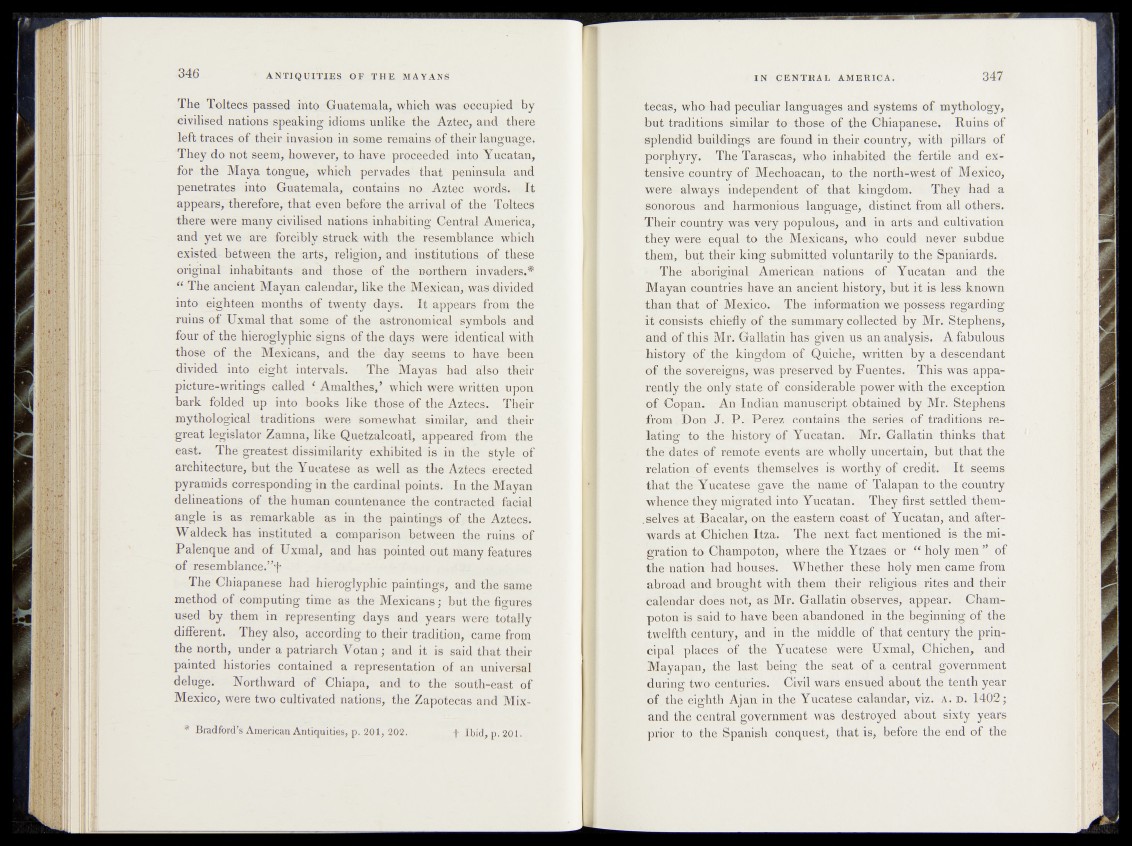
The Toltecs passed into Guatemala, which was occupied by
civilised nations speaking idioms unlike the Aztec, and there
left traces of their invasion in some remains of their language,
They do not seem, however, to have proceeded intoYneatan,
for the Maya tongue, which pervades that peninsula and
penetrates into Guatemala, contains no Aztec words, It
appears, therefore, that even before the arrival of the Toltecs
there were many civilised nations inhabiting Central America»
and yet we are forcibly, struck with the resemblance which
existed between the arts, religion, and institutions of these
original inhabitants and those of the northern invaders.*
“ The ancient Mayan calendar, like the Mexican,.was divided
into eighteen months of twenty days. It appears from the
ruins of Uxmal that some of the astronomical symbols and
four of the hieroglyphic signs of the days were identical with
those of the Mexicans, and the day seems to hay e— teen
divided into eight intervals. The Mayas hack* also 'their
picture-writings called ‘ Amalthes,’ which were written upon
bark folded up into books like those of the Aztecs. Their
mythological traditions were somewhat similar, and their
great legislator Zamna, like Quetzalcoatl, appeared from the
east. The greatest dissimilarity exhibited is in the’ style- Cf
architecture, but the Yueatese as well as the Aztees erected
pyramids corresponding in the cardinal points. In the Mayan
delineations of the human countenance the contracted facial
angle is as remarkable as in the paintings -Qf the Aztecs.
Waldeck has instituted a comparison between the ruins of
Palenque and of Uxmal, and has pointed out many features
of resemblance.”+
The Chiapanese had hieroglyphic paintings, and the same
method of computing time as.the Mexicans; but the figures
used by them in representing days and years were totally
different. They also, according to their tradition, came from
the north, under a patriarch Votan; and it is said that their
painted histories contained a representation of an universal
deluge. Northward of Chiapa, and to the south-east of
Mexico, were two cultivated nations, the Zapotecas and Mixtecas,
wbo-bad peculiar languages and systems of mythology,
bu$ traditions-.similar to those of the Chiapanefev: Ruins of
splendid buildings are found in thesk’ country; with pillars of
-pdrphyryj^ The Tara-scaS, who.,.inhabited^ the: fertile and extensive'
'■country of ppehojacan,. teethe north-west'-öf Mexico,
were-v always o f k i n g d o m. They had a
sonorous and harmonio#$'la>K%u^gg^^stinct frpda all others,
Tbeii\e@uutry wasveryl*p^p‘ulons> and -in arts and cultivation
they weEe equal vto the tMléxi0^hsj‘f'who-„^uld never subdue
them, but: their> king .submitted voluPtariliyi-tOi «the. Spaniards.'
I The aboriginal-- A m e r i c a n a i n a t i o n s a n d the
Mayan countries have an ancient history., but it:is less known
than that of Mexico. The information wejpossess' regarding
it cönsisfs #||€ffly of the^summary collected «by Mr. -Stephens,
and of this Mr. Gallatin has given{p#;/a#Tan%lysiS'. A-fabulous
h i s to r y ,th e kingdom of Quiche,, written -by ;a. descendant
of the sovereigns, was p^served, by PueN®4&f»Thiswas apparently
the-only-state o f. considexabl^power with the .-exertion
of Oopan. An Indian manuscri-pkobtamed by Mr. Stephens,
Jrom. Don J. P. Perez. fpputains theu.sè.rieÉSof traditions relating
to the-history of Y ucataru**, Mr .^Gallatin thinks that
the ctates .of remote events-are wholly uncertain,'' but that the
'relation .ofv events themselves is worthy of credit! i, It^sefems
that the-Yucatese gave» the^name of T-alapah,to; the country
whence they migrated into Yucatan. They-first settled'them-
. selves at BacalarT on the eastern coast of Yucatan, and afterwards
at Chichen Itza. The next fact mentioned is the migration
to Champoton, where the Ytzaes or “ holy men of
the nation had houseè. ' Whether these, holy i ^ n came from
abroad and brought with them their relfgfeus,rites and their
Calendar does not, as Mr. Gallatin observes, appear. Champoton
is said to have been abandoned, in the beginningiof ■ the
twelfth century, and in the'/middle of that century the principal
places of the Yucate.se- weréi Uxmal, Chichen, and
Mayapan, the last being the seat of a central government
during two centuries. ’ Civil wars ensued about the tenth year
of the eighth Ajan in the Yucatej^nalandar, viz. a. d. 1402;
and the central government was destroyed about sixty years
prior to the Spanish conquest, that is, before the end of the